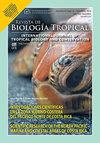Bryde’s Whale (Balaenoptera edeni brydei, Artiodactyla: Balaenopteridae) aggregation area in the Gulf of Chiriqui, Panama
IF 0.6
4区 生物学
Q4 BIOLOGY
引用次数: 0
Abstract
Introduction: Even though they occur worldwide in tropical and subtropical waters, Bryde’s whales (Balaenoptera edeni) are one of the most enigmatic of all the balaenopterid species. Previous research has reported the presence of Bryde’s whales off the Pacific coast of Panama, but little is known about their behaviors, abundance, and distribution in these waters. Objective: We report on an area in the Gulf of Chiriqui, Panama, where Bryde’s whales have regularly been sighted. Methods: We conducted small-boat surveys for marine mammals in the Gulf of Chiriqui between 2001 and 2022, during both the austral (26 300 km) and boreal (4 700 km) winter seasons. Results: We made 25 sightings of 33 Bryde’s whales. Sightings were made in nine of the years surveyed, and most were in the austral winter season (92 %). Most sightings were of one animal (80 %), and one sighting was of a mother-calf-escort trio. The aggregation area appears near the Contreras Islands, where most sightings (84 %) were made. We have photo-identified 14 individual whales using the dorsal fin. One individual has been sighted over two years (2014 and 2015), while the remaining have been documented only once. No photographic matches have been made to other areas. Conclusions: The persistent use of this aggregation area could indicate it is used for foraging, and the presence of a calf may indicate the area is also used for reproduction. The one inter-annual resight suggests this area may be used repeatedly by some of the same animals. Further research is needed off Panama to better understand this population of Bryde’s whales, its conservation status, and its relationship to the broader eastern tropical Pacific populations. Expanding the marine protected areas in the Gulf of Chiriqui may be warranted in order to protect this aggregation area.巴拿马奇里基湾布氏鲸(Balaenoptera edeni brydei,偶蹄目:布氏鲸科)聚集区
简介:尽管布氏鲸(Balaenoptera edeni)分布在世界各地的热带和亚热带水域,但它们是所有balaenopterd物种中最神秘的一种。以前的研究报告了巴拿马太平洋海岸外布氏鲸的存在,但对它们在这些水域的行为、数量和分布知之甚少。目的:我们报道了巴拿马奇里基湾的一个区域,在那里经常可以看到布氏鲸。
方法:在2001年至2022年期间,我们在奇里基湾的南部(26300公里)和北部(4700公里)冬季对海洋哺乳动物进行了小船调查。结果:我们发现了33头布氏鲸25次。在调查的年份中,有9年出现了目击事件,大多数发生在南方的冬季(92%)。大多数目击是一只动物(80%),还有一次目击是母子三重奏。聚集区出现在孔特雷拉斯群岛附近,大多数目击事件(84%)发生在那里。我们已经用照片识别了14只使用背鳍的鲸鱼,其中一只在两年内(2014年和2015年)被发现,而其余的只被记录了一次。其他地区没有照片匹配。
结论:这个聚集区的持续使用可能表明它是用于觅食的,而小牛的存在可能表明该区域也用于繁殖。一次年际观察表明,这片区域可能被一些相同的动物反复使用。为了更好地了解布莱德鲸的种群,它的保护状况,以及它与更广泛的东热带太平洋种群的关系,需要在巴拿马附近进行进一步的研究。扩大奇里基湾的海洋保护区可能是必要的,以保护这一聚集区。
本文章由计算机程序翻译,如有差异,请以英文原文为准。
求助全文
约1分钟内获得全文
求助全文
来源期刊

Revista De Biologia Tropical
生物-生物学
CiteScore
1.80
自引率
0.00%
发文量
23
审稿时长
4-8 weeks
期刊介绍:
The Revista de Biología Tropical / International Journal of Tropical Biology and Conservation is a mainstream scientific journal published since 1953 and covered by Web of Science; Science Citation Index; Current Contents; Google Scholar; Scopus, SciELO and nearly 50 additional indices.
A double blind system guarantees you a fair evaluation, and our world class editorial and scientific boards provides a first decision in three working days. The journal is Full Open Access and is widely read where your article can have the highest real impact.
Since its beginning in 1953, the Revista follows these principles: objective and independent evaluation of all manuscripts; transparency in all processes; ethical use of procedures, data, specimens and subjects; fair treatment of all parties; and absolute predominance of scientific rigor over any other aspect.
 求助内容:
求助内容: 应助结果提醒方式:
应助结果提醒方式:


